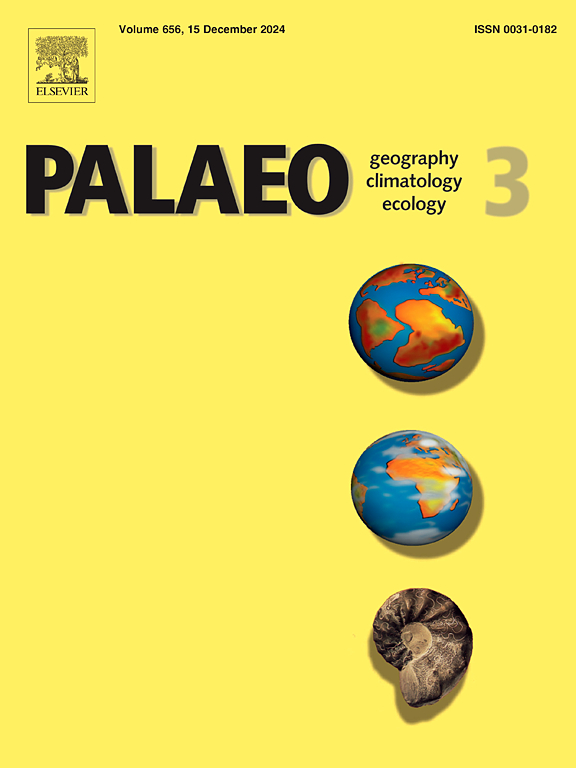法国南部Lophiodontidae(哺乳纲,Perissodactyla)饮食偏好的进化
IF 2.7
2区 地球科学
Q2 GEOGRAPHY, PHYSICAL
Palaeogeography, Palaeoclimatology, Palaeoecology
Pub Date : 2025-06-01
DOI:10.1016/j.palaeo.2025.113076
引用次数: 0
摘要
始新世时期,齿龙科经历了体重增加和前磨牙磨牙化的趋势,这两种现象通常与饮食变化有关。虽然是当时欧洲大陆上最大的食草动物之一,但这个成功的异趾龙家族的生态学很少被研究。这项研究首次利用牙釉质微观结构、牙介面磨损和微磨损(DMTA)与体重的关系来研究牙颌类动物饮食偏好的时间演变。我们研究了来自法国南部7个地点的Lophiodontidae(188个标本),时间为早期伊普雷斯(哺乳动物古近纪水平)MP7-8 + 9[区间,调色板),中期伊普雷斯(~ MP8 + 9, La Borie, Sainte-Eulalie),晚期伊普雷斯(~ MP10 Naples 2;MP10-11 [interval, auumelas), Lutetian (?)MP11-12,圣马丁-德-伦敦)和后期巴顿(MP16,罗比亚克;家庭成员最后出场日期)。在牙釉质微观结构方面,只有来自Palette的Lophiaspis maurettei可以通过其Schmelzmuster来区分,其内放射状牙釉质占很大比例,低辐度,直的Hunter-Schreger带。三个最古老和最小的lophiodontids (85-350 kg)的介观磨损表明相似的浏览偏好,而DMTA和微观结构排除了磨料和坚硬物品的消耗。所有的代理表明坚韧的叶片浏览,与传统的观点形成鲜明对比的所有茎前趾是果性的。我们的研究结果表明,较年轻且体型巨大的Lophiodon lautricense(~ 2300公斤)消耗更多研磨性和较硬的物品。牙釉质厚度的相对减少和磨牙化的增加似乎是与MECO事件相关的家族灭绝之前的一种尝试性饮食适应。本文章由计算机程序翻译,如有差异,请以英文原文为准。
Evolution of dietary preferences of the Lophiodontidae (Mammalia, Perissodactyla) from Southern France
During the Eocene, the Lophiodontidae experienced an increase in body mass and a tendency towards the molarisation of the premolars, two phenomena often related with dietary changes. Although being amongst the largest herbivores of the European landmass at that time, the ecology of this successful perissodactyl family has rarely been investigated. This work is the first to take interest in the temporal evolution of dietary preferences of lophiodontids using enamel microstructure, dental mesowear and microwear (DMTA), in relation to body mass. We studied the Lophiodontidae (188 specimens) from seven Southern France localities dated from the early Ypresian (Mammal Palaeogene levels ]MP7–8 + 9[ interval, Palette), middle Ypresian (∼MP8 + 9, La Borie, Sainte-Eulalie), late Ypresian (∼MP10 Naples 2; ]MP10–11[interval, Aumelas), Lutetian (?MP11–12, Saint-Martin-de-Londres) and late Bartonian (MP16, Robiac; Last Appearance Datum of the family). Regarding enamel microstructure only Lophiaspis maurettei from Palette can be discriminated by its Schmelzmuster, with a large proportion of inner radial enamel, low decussation and straight Hunter-Schreger bands. The mesowear of the three oldest and smallest lophiodontids (85–350 kg) suggests similar browsing preferences, while the DMTA and microstructure exclude the consumption of abrasive and hard items. All proxies indicate tough foliage browsing, contrasting with the traditional view of all stem perissodactyls being frugivorous. Our results suggest that the younger and giant-sized Lophiodon lautricense (∼ 2300 kg) consumed more abrasive and harder items. Relative reduction of enamel thickness and increase in molarisation appears as a tentative dietary adaptation prior to the family extinction in relation with the MECO event.
求助全文
通过发布文献求助,成功后即可免费获取论文全文。
去求助
来源期刊
CiteScore
5.90
自引率
10.00%
发文量
398
审稿时长
3.8 months
期刊介绍:
Palaeogeography, Palaeoclimatology, Palaeoecology is an international medium for the publication of high quality and multidisciplinary, original studies and comprehensive reviews in the field of palaeo-environmental geology. The journal aims at bringing together data with global implications from research in the many different disciplines involved in palaeo-environmental investigations.
By cutting across the boundaries of established sciences, it provides an interdisciplinary forum where issues of general interest can be discussed.

 求助内容:
求助内容: 应助结果提醒方式:
应助结果提醒方式:


